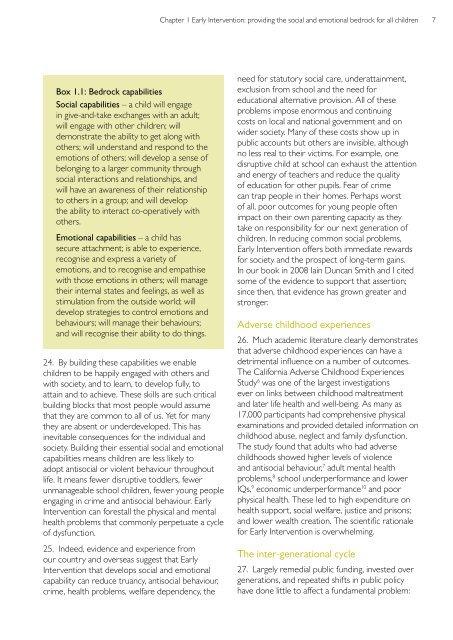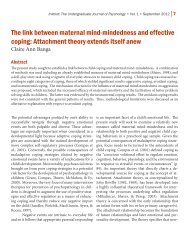early-intervention-next-steps
early-intervention-next-steps
early-intervention-next-steps
You also want an ePaper? Increase the reach of your titles
YUMPU automatically turns print PDFs into web optimized ePapers that Google loves.
Box 1.1: Bedrock capabilities<br />
Social capabilities – a child will engage<br />
in give-and-take exchanges with an adult;<br />
will engage with other children; will<br />
demonstrate the ability to get along with<br />
others; will understand and respond to the<br />
emotions of others; will develop a sense of<br />
belonging to a larger community through<br />
social interactions and relationships, and<br />
will have an awareness of their relationship<br />
to others in a group; and will develop<br />
the ability to interact co-operatively with<br />
others.<br />
Emotional capabilities – a child has<br />
secure attachment; is able to experience,<br />
recognise and express a variety of<br />
emotions, and to recognise and empathise<br />
with those emotions in others; will manage<br />
their internal states and feelings, as well as<br />
stimulation from the outside world; will<br />
develop strategies to control emotions and<br />
behaviours; will manage their behaviours;<br />
and will recognise their ability to do things.<br />
24. By building these capabilities we enable<br />
children to be happily engaged with others and<br />
with society, and to learn, to develop fully, to<br />
attain and to achieve. These skills are such critical<br />
building blocks that most people would assume<br />
that they are common to all of us. Yet for many<br />
they are absent or underdeveloped. This has<br />
inevitable consequences for the individual and<br />
society. Building their essential social and emotional<br />
capabilities means children are less likely to<br />
adopt antisocial or violent behaviour throughout<br />
life. It means fewer disruptive toddlers, fewer<br />
unmanageable school children, fewer young people<br />
engaging in crime and antisocial behaviour. Early<br />
Intervention can forestall the physical and mental<br />
health problems that commonly perpetuate a cycle<br />
of dysfunction.<br />
25. Indeed, evidence and experience from<br />
our country and overseas suggest that Early<br />
Intervention that develops social and emotional<br />
capability can reduce truancy, antisocial behaviour,<br />
crime, health problems, welfare dependency, the<br />
Chapter 1 Early Intervention: providing the social and emotional bedrock for all children<br />
need for statutory social care, underattainment,<br />
exclusion from school and the need for<br />
educational alternative provision. All of these<br />
problems impose enormous and continuing<br />
costs on local and national government and on<br />
wider society. Many of these costs show up in<br />
public accounts but others are invisible, although<br />
no less real to their victims. For example, one<br />
disruptive child at school can exhaust the attention<br />
and energy of teachers and reduce the quality<br />
of education for other pupils. Fear of crime<br />
can trap people in their homes. Perhaps worst<br />
of all, poor outcomes for young people often<br />
impact on their own parenting capacity as they<br />
take on responsibility for our <strong>next</strong> generation of<br />
children. In reducing common social problems,<br />
Early Intervention ofers both immediate rewards<br />
for society and the prospect of long-term gains.<br />
In our book in 2008 Iain Duncan Smith and I cited<br />
some of the evidence to support that assertion;<br />
since then, that evidence has grown greater and<br />
stronger.<br />
Adverse childhood experiences<br />
26. Much academic literature cl<strong>early</strong> demonstrates<br />
that adverse childhood experiences can have a<br />
detrimental infuence on a number of outcomes.<br />
The California Adverse Childhood Experiences<br />
Study6 was one of the largest investigations<br />
ever on links between childhood maltreatment<br />
and later life health and well-being. As many as<br />
17,000 participants had comprehensive physical<br />
examinations and provided detailed information on<br />
childhood abuse, neglect and family dysfunction.<br />
The study found that adults who had adverse<br />
childhoods showed higher levels of violence<br />
and antisocial behaviour, 7 adult mental health<br />
problems, 8 school underperformance and lower<br />
IQs, 9 economic underperformance10 and poor<br />
physical health. These led to high expenditure on<br />
health support, social welfare, justice and prisons;<br />
and lower wealth creation. The scientifc rationale<br />
for Early Intervention is overwhelming.<br />
The inter-generational cycle<br />
27. Largely remedial public funding, invested over<br />
generations, and repeated shifts in public policy<br />
have done little to afect a fundamental problem:<br />
7



